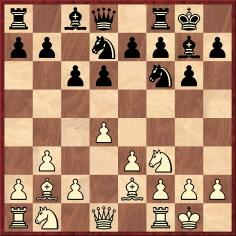
Edward Winter
Mike Salter (Sydney, Australia) notes the comment after 7...c6 in Tartakower’s notes to his game against Speijer (St Petersburg, 1909) in Tartakowers Glanzpartien 1905-1930. The following is from page 45 of the second edition (Berlin and New York, 1986), after the moves 1 d4 Nf6 2 Nf3 d6 3 b3 g6 4 Bb2 Bg7 5 e3 O-O 6 Be2 Nbd7 7 O-O c6:

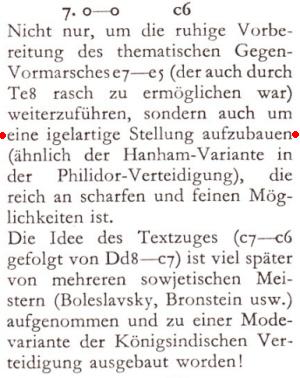
We add below the note as it appeared on page 59 of Tartacover vous parle (Paris, 1953):
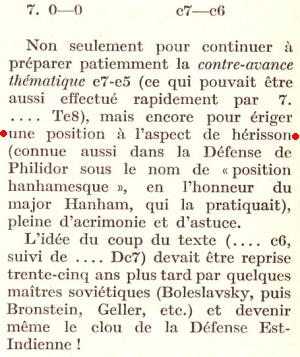
And from page 39 of Tartakower’s My Best Games of Chess 1905-1930 (London, 1953):
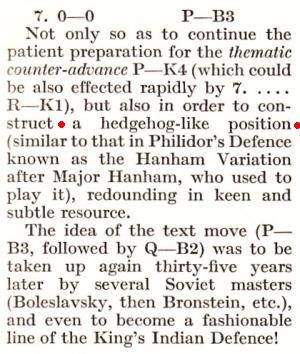
Mr Salter asks whether this is the first reference in chess literature to a ‘hedgehog’ formation. Citations from readers will be appreciated.
We note that on page 171 of the June 1951 Chess Review Tartakower annotated his win over Vidmar (Vienna, 1905). After 1 e4 c5 2 d4 cxd4 3 Nf3 Nc6 4 Nxd4 Nf6 5 Nc3 d6 6 Be2 g6 ...
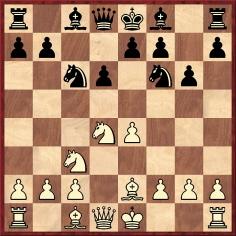
... Tartakower commented:
‘The Dragon Variation was very popular in those days and was in fact a favorite weapon of my own. I had for example won some impressive games in the Hauptturnier at Barmen in 1905.
Some 15 years later, with the rise of the Hypermodern School, the less obvious merits of the Scheveningen Variation began to be appreciated. This line, which calls for 6...e6, is characterized by the position of the black pawns at e6 and d6 and gives the player of the black pieces a kind of “hedgehog” position.’
(7574)
Brian Karen (Levittown, NY, USA) adds a citation from page 69 of 500 Master Games of Chess by S. Tartakower and J. du Mont (London, 1952):
‘In this, the normal position of the Steinitz Defence, Black occupies a “hedgehog” formation. All his minor pieces are in a state of expectant defence. White has now a large choice of good continuations, but none likely to upset Black’s defensive formation.’
The note came after 1 e4 e5 2 Nf3 Nc6 3 Bb5 Nf6 4 O-O d6 5 d4 Bd7 6 Nc3 Be7 7 Re1 exd4 8 Nxd4 O-O in Tarrasch v Lasker, second match-game, 1908.
The image of a curled-up hedgehog was used by Nimzowitsch on pages 70 and 115 of Die Praxis meines Systems (Berlin, 1930); see pages 100 and 163 of The Praxis of My System (London, 1936).
On page 202 of the September 1937 Chess Review Paul Hugo Little wrote regarding the game Pipiringos v Hahlbohm, Chicago, 1937:
‘[Pipiringos] got himself into a weird position resembling one of Steinitz’s hedgehog defenses, and quickly lost.’
(8211)
Christian Sánchez (Rosario, Argentina) points out hedgehog references on page 69 of El Ajedrez Americano, March 1931, concerning the line 1 e4 e5 2 Nf3 Nc6 3 Bb5 d6 4 d4 Bd7 5 Nc3 Nf6 6 O-O Be7 7 Re1 exd4 8 Nxd4 O-O:
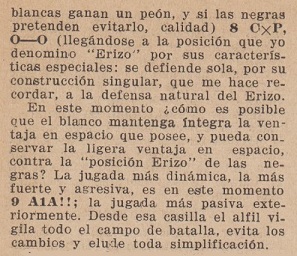
The text was in an extract from a lecture on openings which Tartakower gave in Buenos Aires on 3 March 1931, as specified by the magazine in its heading on the previous page:
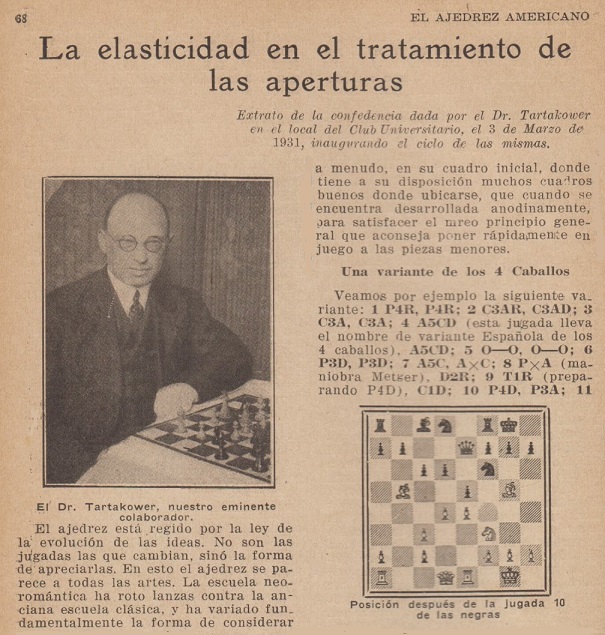
(9947)
John Donaldson (Berkeley, CA, USA) writes:
‘Bobby Fischer’s contributions include countless opening innovations and original middlegame plans. His pioneering use of the King’s Indian Attack is an example of how he seamlessly combined the two, and his wins against Ivkov (Second Piatigorsky Cup, 1966), Myagmarsuren (Sousse Interzonal, 1967) and Panno (Buenos Aires, 1970) are still model games half a century later.
Fischer is also one of the founding fathers of the Hedgehog. Ulf Andersson and Ljubomir Ljubojević played it extensively in the 1970s and 1980s and are credited with being its creators, but, as will be shown below, this is not completely true.
García Soruco v Fischer, Havana Olympiad, 1966 is credited as the game where the plan …Kh8, ...Rg8, …g5, …Rg6 and …Rag8 was first seen, but this may not be so. On pages 18-20 of the 1974 book Morphy Chess Masterpieces by Fred Reinfeld and Andrew Soltis the latter points out that Fischer may have been influenced by Paulsen v Morphy, New York, 1857, where Black played ...Kh8, ...Rg8 and ...g5. The pawn structure is different, but there is some similarity. Here is how the Hedgehog may have developed.
Both players were without sight of the board in the game, which was played on 10 October 1857 and is on page 30 of Hans Renette’s monograph on Paulsen.
1 e4 e5 2 Nf3 Nc6 3 Nc3 Bc5 4 Bb5 d6 5 d4 exd4 6 Nxd4 Bd7 7 Nxc6 bxc6 8 Ba4 Qf6 9 O-O Ne7 10 Be3 Bxe3 11 fxe3 Qh6 12 Qd3 Ng6 13 Rae1 Ne5 14 Qe2 O-O 15 h3
15...Kh8 16 Nd1 g5 17 Nf2 Rg8 18 Nd3 g4 19 Nxe5 dxe5 20 hxg4 Bxg4 21 Qf2 Rg6 22 Qxf7 Be6 23 Qxc7
Morphy now announced mate in five starting with 23…Rxg2+.
The next game, considered the first example of the plan being executed in its entirety, comes from the 1966 Olympiad in Havana (Julio García Soruco v Bobby Fischer):
1 e4 c5 2 Nf3 d6 3 d4 cxd4 4 Nxd4 Nf6 5 Nc3 a6 6 Bc4 e6 7 Bb3 b5 8 a3 Be7 9 Be3 O-O 10 O-O Bb7 11 f3 Nbd7 12 Qd2 Ne5 13 Qf2 Qc7 14 Rac1
14...Kh8
Passive moves (a3, f3 and Rac1) by the Bolivian Olympiad team member are just the encouragement that Fischer needs to implement what Kasparov calls the “compressed spring” strategy.
15 Nce2 Rg8 16 Kh1 g5 17 h3 Rg6
17...d5 is a good move, but it reduces the tension. The text gives White more problems to solve.
18 Ng3?
White cannot just sit tight. He had to try something active, such as 18 Rfd1 Rag8 19 c4, with the idea of 19...bxc4 20 Bxc4 Nxc4 21 b3.
18...Rag8
18...d5 was again quite good for Black, but Fischer adheres to his strategy and is soon rewarded.
19 Nxe6?
This simply loses, but it is hard to suggest a satisfactory defense.
19...fxe6 20 Bxe6 Nxe4 21 Nxe4 Rxe6 22 White resigns.
Fischer’s first try with the variation worked like a charm, his opponent allowing him to do everything he wanted. The second time around, matters were not so simple. The 19-year-old Ulf Andersson was not yet a world-class grandmaster, but he was a strong player (rated 2480 on the July 1970 FIDE rating list, which placed him in the top 100 players in the world at the time).
This game between Fischer and Andersson was played in a hotel room in Siegen on 26 September 1970, the day after the Olympiad ended. Fischer was paid a fee by a Swedish newspaper, which published the game-score a move a day over several months.
1 b3
This was not the first time that Fischer opened with 1 b3, as he had played it a few months before against Tukmakov in Buenos Aires. Fischer stated that 1 e4! is "best by test" (C.N. 4423), but he had a much better career record with 1 b3 – a perfect 4-0 score, in fact. All the games were played against quality opponents (Mecking and Filip were the two others) and were interesting fights in which Fischer introduced new ideas.
1...e5 2 Bb2 Nc6 3 c4 Nf6 4 e3 Be7 5 a3 O-O 6 Qc2
6 d3 d5 7 cxd5 Qxd5 8 Nc3 Qd6 9 Nf3 Bf5 10 Qc2 Rfd8 11 Rd1 h6 12 h3 Qe6 13 Nd2 Nd7 14 Be2 Kh8?! (14...Qg6 (Kasparov)) 15 O-O Bg6 16 b4 a6 17 Rc1 Rac8 18 Rfd1 f5 19 Na4 Na7 20 Nb3 b6 21 d4 f4 22 e4 and White soon won in Fischer v Tukmakov, Buenos Aires, 1970.
6...Re8
6...d5 7 cxd5 (7 d3) 7...Nxd5 8 Nf3 Bf6 9 d3 g6 10 Nbd2 Bg7 11 Rc1 was a dream Sicilian for White in Petrosian v Sosonko, Tilburg, 1981. Black is actually two tempi down on normal lines in the Scheveningen (colors reversed) as he has spent three moves with his king’s bishop instead of one.
7 d3 Bf8 8 Nf3 a5 9 Be2 d5 10 cxd5 Nxd5 11 Nbd2 f6
Andersson supports his e-pawn with the text, but step-by-step he is drifting into a passive position where he will soon have no constructive plan.
Soltis suggests 11...g6 followed by ...Bg7 as Sosonko played, but it would seem that ...g6, ...Bg7 and ...d5 in the opening save a couple moves over ...Be7-f8-g7.
12 O-O Be6 13 Kh1!!
“The exclamation points are not awarded to this move, but rather to Fischer’s entire plan. It is the originality of the plan that merits praise. Later, this plan became popular in Hedgehog positions, where (with colors reversed) White’s c-pawn is on his fourth rank.” (Alex Fishbein on page 48 of his 1996 book on Fischer.)
13...Qd7 14 Rg1 Rad8 15 Ne4!
15...Qf7
If 15...h5 then 16 h3 with g4 to follow. In fact, Black has no way to stop g4, as the noted Hedgehog expert Sergey Shipov points out:
15...Kh8 16 g4! Bxg4 17 Rxg4! Qxg4 18 Nxe5 Qe6 19 Bg4 Qg8 20 Nxc6 bxc6 21 Rg1! with powerful compensation for the exchange.
15...Nb6 16 g4! Bxg4 17 Nh4 f5 18 Nxf5 Qxf5 (or 18...Bxe2 19 Nf6+ Kh8 20 Nxd7 Bf3+ 21 Rg2 Rxd7 22 Nh4 Bxg2+ 23 Kxg2) 19 Bxg4 Qf7 20 d4 exd4 21 Ng5. In both cases White is winning.
16 g4! g6?!
This unforced weakening increases the strength of g4-g5.
16...Nb6 17 Nfd2 Be7 (Shipov) or 17...Bd5 (Kasparov) would have offered complicated play.
17 Rg3 Bg7 18 Rag1!
“A remarkable attacking construction! The original source, with reversed colours, was the game Soruco v Fischer (Havana Olympiad, 1966).” (Kasparov on page 353 of his 2004 book on Fischer in the Predecessors series.)
18...Nb6 19 Nc5! Bc8 20 Nh4 Nd7?
Black had to sacrifice the exchange for a pawn: 20...Rd5 21 Bf3 Rxc5 22 Qxc5 Qxb3 with chances for both sides (Shipov).
21 Ne4!
“An amazing paradox: with the board full of pieces, practically without coming into contact with the enemy army and not straying beyond his own half of the board, White has imperceptibly achieved a winning position.” (Kasparov on page 353 of his 2004 book on Fischer in the Predecessors series.)
21...Nf8 22 Nf5! Be6 23 Nc5 Ne7 24 Nxg7! Kxg7 25 g5! Nf5 26 Rf3 b6 27 gxf6+ Kh8 28 Nxe6 Rxe6
29 d4! exd4 30 Bc4 d3 31 Bxd3 Rxd3 32 Qxd3 Rd6 33 Qc4 Ne6 34 Be5 Rd8 35 h4 Nd6 36 Qg4 Nf8 37 h5 Ne8 38 e4 Rd2 39 Rh3 Kg8 40 hxg6 Nxg6 41 f4 Kf8 42 Qg5 Nd6 43 Bxd6+ Resigns.
“This game made such a great impression on Ulf Andersson that in the 1970s the talented Swedish grandmaster, who is well known for his skill in defence, became one of the main ideologists of the ‘hedgehog’ set-up and the ‘compressed spring’ method when playing Black. That is how the chess revolution of the 1970s began.” (Kasparov on page 354 of his 2004 book on Fischer in the Predecessors series.)
Here, just a day after the game with Andersson, Fischer has the opportunity to use his plan once again, as Black against Michels in the simultaneous display in Münster referred to in C.N. 11543. White’s fate is similar to what would have happened to García Soruco if he had not self-destructed with 19 Nxe6.
1 e4 c5 2 Nf3 d6 3 d4 cxd4 4 Nxd4 Nf6 5 Nc3 a6 6 Bd3 e6 7 Nb3 Be7 8 O-O Qc7 9 Qe2
9 Be3 Nbd7 10 f4 O-O 11 Qf3 is a popular main line.
9...Nbd7 10 Be3 O-O 11 f3?!
11 f4 is necessary as the text is too passive.
11...b6 12 Qf2 Bb7 13 Rfd1 Rac8 14 Rac1
White has no constructive plan.
14...b5 15 a3 Ne5 16 Kh1 Kh8
17 Bb6 Qb8 18 Rd2 Rg8 19 Rcd1 g5 20 Bd4 Rg6 21 Qf1 Rcg8 22 a4
White decides that he cannot wait forever.
22 Qe1 Bd8 23 Qf1 Bc7 followed by a break with ...d5 is another idea at Black’s disposal. If 22 Qg1 then 22...Nxd3 23 cxd3 e5 24 Be3 d5.
22...bxa4 23 Nxa4
23 Na5 had to be tried.
23...Rh6
23...g4! 24 f4 Nxd3 25 cxd3 g3! 26 h3 e5! 27 f5 Rg4! 28 hxg4 exd4 29 Nxd4 Qf8 wins even more quickly.
24 Bxe5 dxe5 25 Nac5 g4! 26 Nxb7 Qxb7
26...Nh5! would have ended matters faster.
27 Bxa6?
27 g3 had to be played.
27...Qa7 28 Qd3 gxf3 29 Na5
As 29 gxf3 is met by 29…Nh5.
29...Ng4 30 gxf3 Qf2 31 White resigns.
In view of these games, should Fischer be considered the father of the Hedgehog? He certainly discovered the key setup with …Kh8, …Rg8, …g5, …Rg6 and ...Rag8. We also know that he was very conscious of Black’s ability to break with …d5 (or when to avoid it). What we do not know for sure, since none of his opponents had their c-pawn on c4 or …c5, is whether he was aware of the …b5 break played independently or in conjunction with …d5. It does seem likely. Less clear is the maneuver …Bf8-e7-d8-c7, a now-standard Hedgehog line, which came into practice only after Fischer had stopped playing post-1972. All in all, it seems fairest to give credit to Fischer as the originator and to Andersson and Ljubojević for refining it.’
(11562)
To the Chess Notes main page.
To the Archives for other feature articles.
Copyright: Edward Winter. All rights reserved.